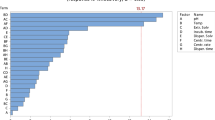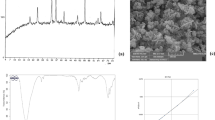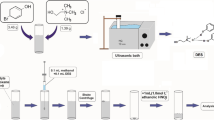Abstract
A fast, green and low cost method for analysis of acrylamide in tap and well water has been presented for the first time using solvent terminated-dispersive liquid liquid microextraction (ST-DLLME) with a simple equipment which does not need centrifugation step followed by GC–FID. The use of one variable at a time optimization method revealed that methanol and octanone were the superior disperser and extraction solvents, respectively. A central composite design (CCD) as a response surface methodology was used for multivariate optimization of five independent factors (volumes of extraction and dispersive solvents, pH, salt addition and extraction time) on the extraction efficiency. Under CCD optimal conditions, the linear range, detection limit (S/N = 3) and quantitation limit (S/N = 10) were 0.1, 0.3 and 0.3–550 ng mL−1, respectively. In these circumstances, the recoveries for real samples (tap and well water) spiked with 0.5, 1 and 10 ng g−1 were in the acceptable range (90.8%–94.1%). In comparison with other methods in the literature, the suggested ST-DLLME approach showed the best analytical performance. The presented green method has potential application as a routine method in the environmental and analytical laboratories for analysis of acrylamide in water samples.


Similar content being viewed by others
References
Backe WJ, Yingling V, Johnson T (2014) The determination of acrylamide in environmental and drinking waters by large-volume injection–hydrophilic-interaction liquid chromatography tandem mass spectrometry. J Chromatogr A 1334:72–78
Brown L, Rhead M (1979) Liquid chromatographic determination of acrylamide monomer in natural and polluted aqueous environments. Analyst 104:391–399
Cavalli S, Polesello S, Saccani G (2004) Determination of acrylamide in drinking water by large-volume direct injection and ion-exclusion chromatography–mass spectrometry. J Chromatogr A 1039:155–159
Chen H, Chen R, Li S (2010) Low-density extraction solvent-based solvent terminated dispersive liquid–liquid microextraction combined with gas chromatography-tandem mass spectrometry for the determination of carbamate pesticides in water samples. J Chromatogr A 1217:1244–1248
DeArmond PD, DiGoregorio AL (2013) Characterization of liquid chromatography-tandem mass spectrometry method for the determination of acrylamide in complex environmental samples. Anal Bioanal Chem 405:4159–4166
Eurachem Guide (2014) The fitness for purpose of analytical methods—a laboratory guide to method validation and related topics, 2nd edn. ISBN 978-91-87461-59-0. http://www.eurachem.org
Farajvand M, Kiarostami V, Davallo M, Ghaedi A (2018) Optimization of solvent terminated dispersive liquid–liquid microextraction of copper ions in water and food samples using artificial neural networks coupled bees. Algorithm Bull Environ Contamination Toxicol 100:402–408
Friedman M, Mottram D (2005) Chemistry and safety of acrylamide in food. Springer, New York
Gałuszka A, Migaszewski ZM, Konieczka P, Namieśnik J (2012) Analytical eco-scale for assessing the greenness of analytical procedures. TrAC Trends Anal Chem 37:61–72. https://doi.org/10.1016/j.trac.2012.03.013
Ghiasvand AR, Hajipour S (2016) Direct determination of acrylamide in potato chips by using headspace solid-phase microextraction coupled with gas chromatography-flame ionization detection. Talanta 146:417–422. https://doi.org/10.1016/j.talanta.2015.09.004
Kiarostami V, Rouini M-R, Mohammadian R, Lavasani H, Ghazaghi M (2014) Binary solvents dispersive liquid–liquid microextraction (BS-DLLME) method for determination of tramadol in urine using high-performance liquid chromatography DARU. J Pharm Sci 22:25
Konieczka P, Namieśnik J (2018) Quality assurance and quality control in the analytical chemical laboratory: a practical approach, analytical chemistry series, 2nd edn. CRC Press, Boca Raton
Lee M-R, Chang L-Y, Dou J (2007) Determination of acrylamide in food by solid-phase microextraction coupled to gas chromatography–positive chemical ionization tandem mass spectrometry. Anal Chim Acta 582:19–23. https://doi.org/10.1016/j.aca.2006.08.042
Lim HH, Shin HS (2013) Ultra trace level determinations of acrylamide in surface and drinking water by GC–MS after derivatization with xanthydrol. J Sep Sci 36:3059–3066
Maham M et al (2013a) Extraction and determination of cyproheptadine in human urine by DLLME-HPLC method. Iran J Pharm Res: IJPR 12:311
Maham M, Kiarostami V, Waqif-Husain S, Karami-Osboo R, Mirabolfathy M (2013b) Analysis of ochratoxin A in malt beverage samples using dispersive liquid-liquid microextraction coupled with liquid chromatography-fluorescence detection. Czech J Food Sci 31:520–525
Maham M, Kiarostami V, Waqif-Husain S, Sharifabadi MK (2014) Analysis of chlorpheniramine in human urine samples using dispersive liquid-liquid microextraction combined with high-performance liquid chromatography. Braz J Pharm Sci 50:551–557
Mnif I, Hurel C, Marmier N (2015) Direct injection method for HPLC/MS/MS analysis of acrylamide in aqueous solutions: application to adsorption experiments. Environ Sci Pollut Res 22:6414–6422
Moradi Z, Kiarostami V, Amini M (2017) Rapid analysis of styrene in drinking water and tea samples using dispersive liquid-liquid microextraction combined with liquid chromatography-ultraviolet detection. Food Anal Methods 10:41–48. https://doi.org/10.1007/s12161-016-0547-x
Płotka-Wasylka J (2018) A new tool for the evaluation of the analytical procedure. Green analytical procedure index. Talanta 181:204–209. https://doi.org/10.1016/j.talanta.2018.01.013
Rezaee M, Assadi Y, Hosseini M-RM, Aghaee E, Ahmadi F, Berijani S (2006) Determination of organic compounds in water using dispersive liquid–liquid microextraction. J Chromatogr A 1116:1–9
Sobhi HR, Ghambarian M, Behbahani M, Esrafili A (2017) Application of modified hollow fiber liquid phase microextraction in conjunction with chromatography-electron capture detection for quantification of acrylamide in waste water samples at ultra-trace levels. J Chromatogr A 1487:30–35. https://doi.org/10.1016/j.chroma.2017.01.051
Wang H, Feng F, Guo Y, Shuang S, Choi MMF (2013) HPLC-UV quantitative analysis of acrylamide in baked and deep-fried Chinese foods. J Food Compos Anal 31:7–11. https://doi.org/10.1016/j.jfca.2013.02.006
WHO (1993) Guidelines for drinking water quality, volume 1, recommendation, 2nd edn. WHO, Geneva
WHO (2002) Health implications of acrylamide in food report of a joint FAO/WHO consultation. WHO, Geneva, pp 25–27
Yamini Y, Ghambarian M, Esrafili A, Yazdanfar N, Moradi M (2012) Rapid determination of ultra-trace amounts of acrylamide contaminant in water samples using dispersive liquid–liquid microextraction coupled to gas chromatography-electron capture detector. Int J Environ Anal Chem 92:1493–1505
Author information
Authors and Affiliations
Corresponding author
Electronic supplementary material
Below is the link to the electronic supplementary material.
Rights and permissions
About this article
Cite this article
Sayah, M., Kiarostami, V. Rapid Analysis of Acrylamide in Tap and Well Water Samples by Solvent Terminated Dispersive Liquid–Liquid Microextraction Followed by GC–FID. Bull Environ Contam Toxicol 102, 560–566 (2019). https://doi.org/10.1007/s00128-019-02575-4
Received:
Accepted:
Published:
Issue Date:
DOI: https://doi.org/10.1007/s00128-019-02575-4




